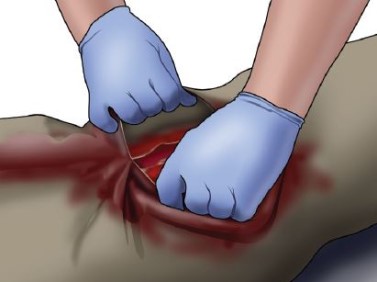In his role as Trauma Medical Director at Victoria General Hospital, Dr. Dennis Kim regularly sees patients whose lives were saved because a bystander knew how to stop them from bleeding to death.
“Just a few days ago a patient was brought into emergency with very badly fractured lower extremities following a high-speed motor crash,” said Dr. Kim. A motorist at the scene stopped and saw they were at risk of bleeding out.
“The motorist had a tourniquet in their trunk and immediately applied it. That action kept the patient alive until they got to the emergency room.”
Stop the Bleed® is an initiative that trains citizens to manage uncontrolled bleeding from major injury. It was initiated by the American College of Surgeons in 2015 in response to the active shooter disaster at Sandy Hook Elementary School in Newtown, CT. Since 2015, Stop the Bleed® has been adopted internationally to provide basic life-saving skills to health-care professionals and members of the public.
The major cause of death following an injury is bleeding from extremities – neck, groin, armpits, chest and abdomen – and Stop the Bleed® techniques can be used in all of those regions.
Adds Dr. Kim, “in so many aspects of our daily lives, there is potential for injury to occur. In the kitchen, driving on the road, hiking and cycling – no matter what age or how safe you are being, we are all potentially at risk.”
As in any health event, the sooner we intervene, the better the outcome. Bystanders are in the best position to respond. Having the skills to stop a person from bleeding out in the time before first responders arrive on the scene can save countless lives. Similar to how we have basic first aid, or the Heimlich Manoeuver and CPR, the sooner we get bleeding under control, the odds of a person surviving increase significantly.
Learning is easy – there are online courses that take just one hour. Learn more at
stopthebleed.ca.
You can get an idea of the training in this 1-minute video of a training event in Vancouver.
The steps are simple. Just follow the ABCs:
- A – Alert
- B – Bleeding
- C – Compress
A – Alert: Call 9-1-1

B – Bleeding: Find the bleeding injury

C – Compress: Apply pressure to stop the bleeding
“One of the roles for Trauma Services BC is to help educate and support all British Columbians to prevent unnecessary deaths due to major injury. If we can get the Stop the Bleed® training to anyone who wants to learn it, then we are working together to save lives. And it’s easy to learn!” said Jo-Ann Hnatiuk, lead clinical initiatives and programs for Trauma Services BC.
Similar to how a lot of public facilities have automated external defibrillators (AEDs) available, tourniquets and bleeding control kits are now being disseminated at key locations in order to give the public access to bleeding control devices in case someone is bleeding to death.
Here are the top five pieces of equipment for you to have on hand in your first aid kit at home, in your car, or with your sporting and camping gear:
- Gloves
- A tourniquet – you can purchase them online at Stop the Bleed, or purchase the Combat Application Tourniquet. “In a pinch,” says Jo-Ann, “anything that provides circumferential pressure will work, such as a tie or a belt.”
- Gauze for packing wounds
- Plastic bag
- Pressure bandage (Ace wrap, anything to apply pressure)
